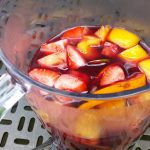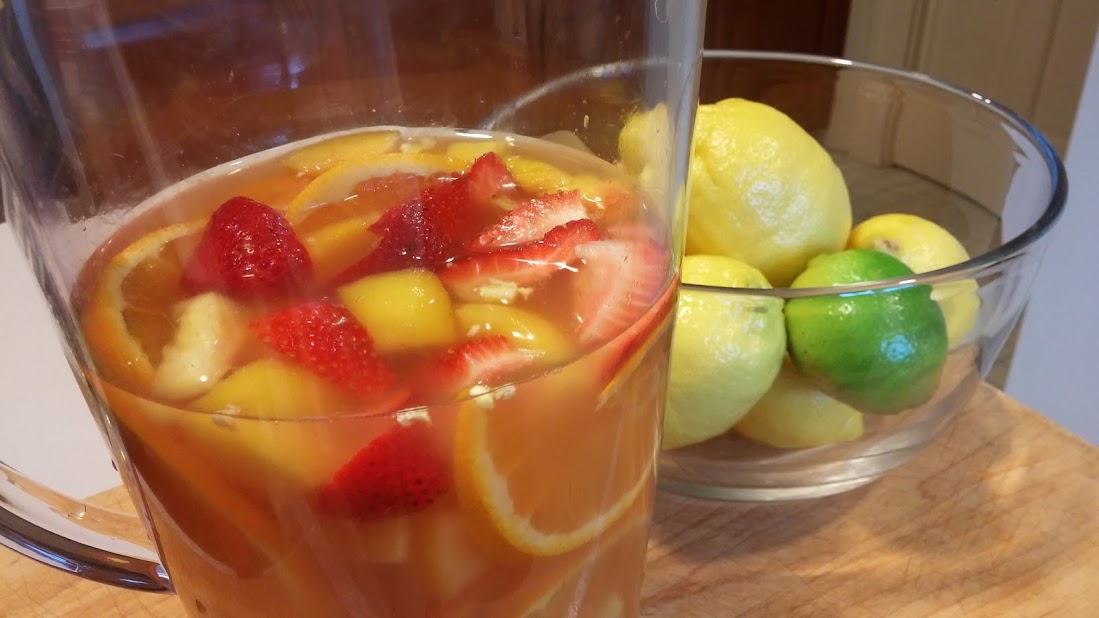 The bright garnet glow of the wine was highlighted by sunny slices of citrus. Beads of water gathering on the pitcher promised a cool drink on a warm day. Sangria was an ideal summer sipper for lazy afternoons and humid evenings.
The bright garnet glow of the wine was highlighted by sunny slices of citrus. Beads of water gathering on the pitcher promised a cool drink on a warm day. Sangria was an ideal summer sipper for lazy afternoons and humid evenings.
Sangria is a cherished tradition in Spain where there’s plenty of red wine, locally grown fruit, and thirsts to quench. Fruity red wine, infused with citrus, lightly sweetened, and fortified with a tot of brandy, is popular across the Iberian peninsula.
 Beyond the basic ingredients, there are lots of recipe options to make Sangria. Some recipes get their fruit kick plus added alcohol from flavored liqueurs like Triple Sec or Cointreau. Juices like pomegranate or orange can be added. For a little fizz, chilled club soda can be added just before serving. A few recipes called for lemon/lime soda, but if you must, use a real juice brand like Pellegrino. A cinnamon stick can be tossed in for an exotic accent.
Beyond the basic ingredients, there are lots of recipe options to make Sangria. Some recipes get their fruit kick plus added alcohol from flavored liqueurs like Triple Sec or Cointreau. Juices like pomegranate or orange can be added. For a little fizz, chilled club soda can be added just before serving. A few recipes called for lemon/lime soda, but if you must, use a real juice brand like Pellegrino. A cinnamon stick can be tossed in for an exotic accent.
Watch out though! Some of these concoctions approach high octane pool-party punch instead of a refreshing wine cooler. I like to keep it simple with natural fruit flavors and lower alcohol. Even with the traditional approach of wine, fruit, and brandy, there are plenty of variations on the theme.
I spoke to writer Arlen Gargagliano author of Mambo Mixers, and Calypso Coolers who has spent some time in Spain. “Sangria is very present in everyday Spanish life,” she told me, “either at a bar with tapas or mixed up at home.” At a bar it can be ordered by the glass or drawn from a colorful bar-top dispenser. Each establishment has their specialty tapas, usually something salty, to be washed down with the house Sangria. At home, it’s made by the pitcher.
Sangria isn’t a reason to splurge on wine. Well-made, modestly-priced, fruit forward are just the ticket. I think first of Spanish wines, but there are a number of options from around the world that can work just as well.
 Holly at Ancona’s wines in Wilton put me on to Lo Brujo Garnacha, a Spanish red from Aragon and Agua de Piedra, a Malbec from Argentina – both from the Two-for-$10 table. Their bright color and lavish fruit flavor make a great base for Sangria.
Holly at Ancona’s wines in Wilton put me on to Lo Brujo Garnacha, a Spanish red from Aragon and Agua de Piedra, a Malbec from Argentina – both from the Two-for-$10 table. Their bright color and lavish fruit flavor make a great base for Sangria.
Joanne at Stew Leonard’s Wines stuck with Spain. Abrazo Tempranillo ($8) from Cariñena was a choice for red. She surprised me with a rosé suggestion, too. What a great idea! Rosés are popular and have the perfect flavors and lovely color for a new take on Sangria. Borsao Rosé ($8) is 100% garnacha and loaded with berry flavors.
White and sparkling wines can also make delicious Sangria. Again, I would look to Spanish wines first. Albariño and Verdejo are widely planted white wine grapes that make bright, easy-drinking wines. Sparkling Spanish Cava is delicious, too. Chill it in advance, and add it at the last minute to keep the fizz.
Sangria is traditionally made with red wine, brandy, simple syrup and citrus fruits, all marinated together as the wine chills. I was surprised to see the brandy, but it turns out Spain is a major brandy producer. It’s a natural addition giving the Sangria more body, taking it up a notch from flavored wine.
A little sweetness is essential to contrast the sharp acidity of the fruit. I held back a little until I could taste the chilled Sangria. You can always add more, but too much makes it sticky-sweet rather than refreshing. Making a simple syrup is the way to go, dissolving sugar into boiling water so it will mix easily with the wine.
 Guide to Wines, Spirits, and Beers, quotes a recipe from the legendary La Fonda del Sol restaurant: Boil up ½ cup sugar and 1 cup water; take it off the heat and marinate a thinly sliced orange and lime in it for at least four hours. He suggests adding a half cup of the flavored syrup to a bottle of wine along with the marinated fruit. The intensely flavored syrup adds a lot to the final flavor. No Brandy in this recipe!
Guide to Wines, Spirits, and Beers, quotes a recipe from the legendary La Fonda del Sol restaurant: Boil up ½ cup sugar and 1 cup water; take it off the heat and marinate a thinly sliced orange and lime in it for at least four hours. He suggests adding a half cup of the flavored syrup to a bottle of wine along with the marinated fruit. The intensely flavored syrup adds a lot to the final flavor. No Brandy in this recipe!
In the June/July issue of Fine Cooking magazine Jeffrey Morgenthaler makes a sweeter syrup of 1 cup sugar and ½ cup water. He doesn’t marinate the fruit, but adds a little orange juice to the wine instead. Add 2 cups of fresh fruit and a ½ cup of brandy and let it all chill for at least 4 hours.
I tried both recipes with red wine. Each was a hit – my tasting panel only wanted more. Just before serving, I added some fresh strawberries, chunks of pineapple, and some frozen peaches instead of ice cubes for a colorful and festive look. I tinkered with the sweetness to get it just right. With the brandy, the Sangria was more complex and satisfying.
 A third batch (We worked hard on this over one weekend!) was made with the Borsao rosé. I added a little orange juice – which unfortunately dimmed the bright rosé color – included brandy, and used up the leftover infused simple syrup, basically a mashup of the two recipes. This mix was a big hit, too. It seems you can’t go wrong with Sangria.
A third batch (We worked hard on this over one weekend!) was made with the Borsao rosé. I added a little orange juice – which unfortunately dimmed the bright rosé color – included brandy, and used up the leftover infused simple syrup, basically a mashup of the two recipes. This mix was a big hit, too. It seems you can’t go wrong with Sangria.
Keep a couple bottles of Spanish wine on hand this summer along with some oranges and limes, and you’ll be ready for a festive, spontaneous Sangria party. Ole!













No Comment